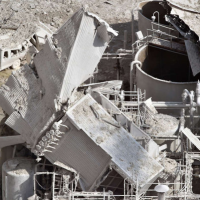What Happened to the Refinery Re-Start that Would Slash California Fuel Prices?
 Exxon/Mobil refinery blast in Torrance (photo: Brad Graverson, Torrance Daily Breeze)
Exxon/Mobil refinery blast in Torrance (photo: Brad Graverson, Torrance Daily Breeze)
Motorists nationwide were assured by analysts at the beginning of September that gasoline prices would plummet in the coming weeks to $2 a gallon for the first time since 2009.
Even California (with its own economic microclimate) would see significant declines because the ExxonMobil refinery in Torrance, substantially closed since an explosion and fire in February, “will ramp up in production in October as it completes repairs.”
Although California prices are down 61 cents from a year ago thanks to the worldwide decline in oil prices, that is half the drop experienced by Indiana, Hawaii, Connecticut, Michigan and Kentucky. Only Nevada had so little improvement.
ExxonMobil and regulators, both state and federal, were already not seeing eye to eye over what refinery changes and repairs were needed to meet safety standards when a small leak of modified hydrofluoric acid on September 6 complicated matters. This week, two members of California’s congressional delegation asked the U.S. Chemical Safety Board (CSB) to broaden its ongoing investigation of the refinery blast to include the acid incident.
The California Division of Occupational Safety and Health (Cal/OSHA) fined ExxonMobil $566,000 (pdf) for 19 violations of workplace and health regulations when its critical fluid catalytic cracker unit, which hadn’t worked properly for nine years, failed in February.
Jordan Blum at Fuel Fix wrote that the South Coast Air Quality Management District (AQMD) this week delayed for the third time consideration of a schedule for ramping up the refinery, which is currently at 20% capacity. There seems to be a disagreement over ExxonMobil using an electrostatic precipitator it retired in 2009, which AQMD spokesman Sam Atwood said would produce “anywhere from two to six times the emissions of the newer unit that was destroyed in the explosion.”
That one refinery has a disproportionate effect on gasoline prices because of the state’s peculiar circumstances. The state uses an eco-friendly gas mixture that requires seasonal refinery switchovers, isolating the market from the rest of the nation. And California has tougher anti-pollution regulations than other states.
Nick Green at the Daily Breeze in Torrance reported a week ago that ExxonMobil has not responded to subpoenas regarding the explosion from the Chemical Safety Board, who have referred the matter to the U.S. Department of Justice (DOJ). A company attorney called the request “overbroad, unduly burdensome and not reasonably related to the CSB’s investigation.”
Jamie Court, president of the advocacy group Consumer Watchdog, summed up for the Los Angeles Times the difficult negotiating position Torrance residents and California motorists are in with ExxonMobil:
“This is a Faustian bargain. This is a bargain with the devil. Our inventories are chronically low. Exxon's got a gun to our heads. It's a no-win situation.”
–Ken Broder
To Learn More:
Exxon Mobil California Refinery Faces More Delays After Acid Leak (by Jordan Blum, Fuel Fix)
Torrance Residents Protest ExxonMobil’s Refinery Safety Record (by Nick Green, Torrance Daily Breeze)
Lower L.A. Gas Prices Coming Soon? Exxon Mobil Is Poised to Increase Output at Torrance Refinery (by Ivan Penn, Los Angeles Times)
ExxonMobil Fined for Blast at Torrance Refinery; Ready to Fire It Back Up (by Ken Broder, AllGov California)
- Top Stories
- Controversies
- Where is the Money Going?
- California and the Nation
- Appointments and Resignations
- Unusual News
- Latest News
- California Forbids U.S. Immigration Agents from Pretending to be Police
- California Lawmakers Urged to Strip “Self-Dealing” Tax Board of Its Duties
- Big Oil’s Grip on California
- Santa Cruz Police See Homeland Security Betrayal in Use of Gang Roundup as Cover for Immigration Raid
- Oil Companies Face Deadline to Stop Polluting California Groundwater





